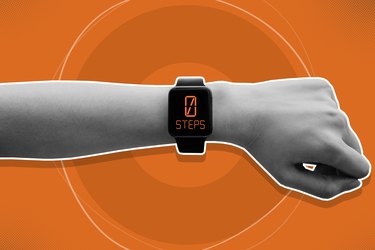
As it becomes more and more difficult for a lot of us to separate work from home, your usual walking routine may start to take a back seat as you spend more time at your desk.
And while you've likely heard all about the effects of sitting all day, the flip side of the above scenario is what's happening to your body when you start walking less (or stop altogether). Here are some unfortunate side effects you can expect.
Video of the Day
Video of the Day
You'll Start to Lose Endurance
When your daily walking routine comes to a halt, you can expect to lose a little endurance, especially if you're not swapping in other forms of exercise, according to New York-based physical therapist Sam Becourtney, DPT, CSCS.
If your cardiovascular system doesn't get the same daily stimulus, you might start to experience increased difficulty performing daily tasks like cooking, cleaning or putting away groceries.
To maintain endurance and keep your heart healthy, aim to get at least 150 minutes of moderate-intensity aerobic exercise each week, recommend the Centers for Disease Control and Prevention. But if you're unable to go for a walk around your block, aerobics, swimming or stationary biking are a few alternatives.
Your Hips May Feel Tighter
Walking is a great way to loosen up tight hips. But stopping, combined with sitting for long periods of time can lead to hip pain, according to Franciscan Health. Creating a more posture-friendly workspace can definitely help, but it won't totally undo the muscle tightness caused by sitting 40 to 50 hours each week.
"Generally, if we stay in any one position for too long, our body does not like that, and we will gradually feel tighter," Becourtney says. "The hips are one of the most common places this is first seen when stopping a walking routine."
If walking isn't an option, performing some hip flexor stretches (like knee grabs and hip rotators) throughout your day can help alleviate some tightness and pain.
You Could Experience Back Pain
Sitting all day (as most of us do) isn't the greatest thing for your posture and back health. And if your usual walking routine gets replaced with longer periods desk-side, your lower back may start to experience some pain, Becourtney says.
"Compounded with a decreased endorphin release, the general lower level of activity and movement increases the likelihood of experiencing pain, specifically in the low back due to sitting longer and walking/standing less," he says.
You Might Feel Ankle or Foot Pain When You Start Back Up
After an abrupt pause to your walking routine, you won't want to jump right back into long-distance walks or jogs. Resuming your usual routine as if your hiatus never happened can cause foot or ankle pain, Becourtney says.
Increasing your activity levels too quickly after being inactive is a common cause of overuse injury, according to the Mayo Clinic. That's why pacing your walks and returning to your previous activity level slowly after a break is crucial.
"If someone stops their daily walking, then these longer walks or runs become more of a shock to the body and may lead to pains due to their irregularity," Becourtney says.
Gradually increasing your walking distance and speed over the course of a month is the safest way to go. You can even follow a weekly plan, starting with 10 minutes of walking at a time, working your way up to 30 or 60 minutes or longer.
